Which Gridded Population Data Product Is Better? Evidences from Mainland Southeast Asia (MSEA)
Abstract
:1. Introduction
2. Materials and Methods
2.1. Study Area
2.2. Data
2.2.1. National Statistical Data and Its Pre-Processing
2.2.2. Four Gridded Population Datasets
2.3. Methodology
2.3.1. GIS-Based Consistent Spatial Comparison
2.3.2. Estimated Errors Comparison
3. Results
3.1. Spatial Differences in the Four Gridded Population Datasets
3.2. The Consistency and Discrepancy of the Four Datasets at the Provincial Level
3.3. Large Errors in Different Population Density and Changing Area
4. Discussion
4.1. Comparative Summaries with the Previous Studies
4.2. Outlook for Future Cross-Comparison and Applications of the Gridded Datasets
4.3. Suggestions for the Gridded Datasets’ Producers and Users
5. Conclusions
Author Contributions
Funding
Acknowledgments
Conflicts of Interest
References
- Abel, C.; Horion, S.; Tagesson, T.; Keersmaecker, D.W.; Seddon, A.W.R.; Abdi, A.M.; Fensholt, R. The human–environment nexus and vegetation–rainfall sensitivity in tropical drylands. Nat. Sustain. 2021, 4, 25–32. [Google Scholar] [CrossRef]
- Feng, Z.; Xiao, C.; Li, P.; You, Z.; Yin, X.; Zheng, F. Comparison of spatio-temporal transmission characteristics of COVID-19 and its mitigation strategies in China and the US. J. Geogr. Sci. 2020, 30, 1963–1984. [Google Scholar] [CrossRef]
- Sarkar, P.; Debnath, N.; Reang, D. Coupled human-environment system amid COVID-19 crisis: A conceptual model to understand the nexus. Sci. Total Environ. 2021, 753, 141757. [Google Scholar] [CrossRef]
- United Nations. World Population Prospects 2019; United Nations Press: New York, NY, USA, 2019. [Google Scholar]
- Naidoo, R.; Fisher, B. Sustainable Development Goals: Pandemic reset. Nature 2020, 583, 198–201. [Google Scholar] [CrossRef]
- Ribeiro, H.V.; Rybski, D.; Kropp, J.P. Effects of changing population or density on urban carbon dioxide emissions. Nat. Commun. 2019, 10, 1. [Google Scholar] [CrossRef] [Green Version]
- Kugler, T.A.; Grace, K.; Wrathall, D.J.; de Sherbinin, A.; Van Riper, D.; Aubrecht, C.; Comer, D.; Adamo, S.B.; Cervone, G.; Engstrom, R.; et al. People and Pixels 20 years later: The current data landscape and research trends blending population and environmental data. Popul. Environ. 2019, 41, 209–234. [Google Scholar] [CrossRef]
- Center for International Earth Science Information Network (CIESIN). Gridded Population of the World, Version 4 (GPWV4): Population Count Adjusted to Match 2015 Revision of un wpp Country Totals, Revision 11; Center for International Earth Science Information Network (CIESIN): New York, NY, USA, 2018. [Google Scholar]
- Melchiorri, M.; Pesaresi, M.; Florczyk, A.; Corbane, C.; Kemper, T. Principles and Applications of the Global Human Settlement Layer as Baseline for the Land Use Efficiency Indicator—SDG 11.3.1. ISPRS Int. J. Geo-Inf. 2019, 8, 96. [Google Scholar] [CrossRef] [Green Version]
- Tatem, A.J. WorldPop, open data for spatial demography. Sci. Data. 2017, 4, 1. [Google Scholar] [CrossRef] [PubMed]
- Dobson, J.E.; Bright, E.A.; Coleman, P.R.; Durfee, R.C.; Worley, B.A. LandScan: A global population database for estimating populations at risk. Photogramm. Eng. Remote Sens. 2000, 66, 849–857. [Google Scholar]
- Burke, M.; Driscoll, A.; Lobell, D.B.; Ermon, S. Using satellite imagery to understand and promote sustainable development. Science 2021, 371, 6535. [Google Scholar] [CrossRef] [PubMed]
- Chen, M.; Sui, Y.; Liu, W.; Liu, H.; Huang, Y. Urbanization patterns and poverty reduction: A new perspective to explore the countries along the Belt and Road. Habitat Int. 2019, 84, 1–14. [Google Scholar] [CrossRef]
- Li, Y.; Derudder, B. Dynamics in the polycentric development of Chinese cities, 2001–2016. Urban Geogr. 2020, 42, 1–21. [Google Scholar] [CrossRef]
- Nguyen, L.H.; Nghiem, S.V.; Henebry, G.M. Expansion of major urban areas in the US Great Plains from 2000 to 2009 using satellite scatterometer data. Remote Sens. Environ. 2018, 204, 524–533. [Google Scholar] [CrossRef]
- Flies, E.J.; Williams, C.R.; Weinstein, P.; Anderson, S.J. Improving public health intervention for mosquito-borne disease: The value of geovisualization using source of infection and LandScan data. Epidemiol. Infect. 2016, 144, 3108–3119. [Google Scholar] [CrossRef] [PubMed] [Green Version]
- Nieves, J.J.; Stevens, F.R.; Gaughan, A.E.; Linard, C.; Sorichetta, A.; Hornby, G.; Patel, N.N.; Tatem, A.J. Examining the correlates and drivers of human population distributions across low- and middle-income countries. J. R. Soc. Interface 2017, 14, 20170401. [Google Scholar] [CrossRef] [Green Version]
- Mohanty, M.P.; Simonovic, S.P. Understanding dynamics of population flood exposure in Canada with multiple high-resolution population datasets. Sci. Total Environ. 2021, 759, 143559. [Google Scholar] [CrossRef]
- Wu, J.; Li, Y.; Li, N.; Shi, P. Development of an Asset Value Map for Disaster Risk Assessment in China by Spatial Disaggregation Using Ancillary Remote Sensing Data. Risk Anal. 2018, 38, 17–30. [Google Scholar] [CrossRef]
- Leyk, S.; Gaughan, A.E.; Adamo, S.B.; de Sherbinin, A.; Balk, D.; Freire, S.; Rose, A.; Stevens, F.R.; Blankespoor, B.; Frye, C.; et al. The spatial allocation of population: A review of large-scale gridded population data products and their fitness for use. Earth Syst. Sci. Data. 2019, 11, 1385–1409. [Google Scholar] [CrossRef] [Green Version]
- Bai, Z.; Wang, J.; Wang, M.; Gao, M.; Sun, J. Accuracy Assessment of Multi-Source Gridded Population Distribution Datasets in China. Sustainability 2018, 10, 1363. [Google Scholar] [CrossRef] [Green Version]
- Archila Bustos, M.F.; Hall, O.; Niedomysl, T.; Ernstson, U. A pixel level evaluation of five multitemporal global gridded population datasets: A case study in Sweden, 1990–2015. Popul. Environ. 2020, 42, 255–277. [Google Scholar] [CrossRef]
- Xu, Y.; Ho, H.C.; Knudby, A.; He, M. Comparative assessment of gridded population data sets for complex topography: A study of Southwest China. Popul. Environ. 2021, 42, 360–378. [Google Scholar] [CrossRef]
- Chen, R.; Yan, H.; Liu, F.; Du, W.; Yang, Y. Multiple Global Population Datasets: Differences and Spatial Distribution Characteristics. ISPRS Int. J. Geo-Inf. 2020, 9, 637. [Google Scholar] [CrossRef]
- Dayley, R. Southeast Asia in the New International Era; Routledge: New York, NY, USA, 2019. [Google Scholar]
- Calka, B.; Bielecka, E. GHS-POP Accuracy Assessment: Poland and Portugal Case Study. Remote Sens. 2020, 12, 1105. [Google Scholar] [CrossRef] [Green Version]
- Gaughan, A.E.; Stevens, F.R.; Linard, C.; Jia, P.; Tatem, A.J. High resolution population distribution maps for Southeast Asia in 2010 and 2015. PLoS ONE. 2013, 8, e55882. [Google Scholar] [CrossRef]
- Robins, L. A policy dialogue on rice futures: Rice-based farming systems research in the Mekong region. In Proceedings of the A Policy Dialogue on Rice Futures: Rice-Based Farming Systems Research in the Mekong Region, Phnom Penh, Cambodia, 7–9 May 2014; ACIAR Proceedings No. 142. Australian Centre for International Agricultural Research: Canberra, Australia, 2014; p. 158. [Google Scholar]
- Langill, J.C.; Willis, A.S. The critical need for reciprocity between educational migrants and communities for continuing education and socio-cultural capital in Laos. Asia Pac. Viewp. 2020, 61, 118–133. [Google Scholar] [CrossRef]
- Rungmanee, S. Unravelling the Dynamics of Border Crossing and Rural-to-Rural-to-Urban Mobility in the Northeastern Thai-Lao Borderlands. Popul. Space Place. 2016, 22, 693–704. [Google Scholar] [CrossRef]
- Sari, B.R. Borders and Beyond: Transnational Migration and Diaspora in Northern Thailand Border Areas with Myanmar and Laos; Yayasan Pustaka Obor Indonesia: Jakarta, Indonesia, 2018. [Google Scholar]
- Giang, L.T.; Nguyen, C.V.; Nguyen, H.Q. The impacts of economic growth and governance on migration: Evidence from Vietnam. Eur. J. Dev. Res. 2020, 32, 1195–1229. [Google Scholar] [CrossRef]
- Xiao, C.; Li, P.; Feng, Z. Re-delineating mountainous areas with three topographic parameters in Mainland Southeast Asia using ASTER global digital elevation model data. J. Mt. Sci. Engl. 2018, 15, 1728–1740. [Google Scholar] [CrossRef]
- Willmott, C.J.; Matsuura, K. Advantages of the mean absolute error (MAE) over the root mean square error (RMSE) in assessing average model performance. Clim. Res. 2005, 30, 79–82. [Google Scholar] [CrossRef]
- Smith, A.; Bates, P.D.; Wing, O.; Sampson, C.; Quinn, N.; Neal, J. New estimates of flood exposure in developing countries using high-resolution population data. Nat. Commun. 2019, 10, 1814. [Google Scholar] [CrossRef] [Green Version]
- Klotz, M.; Kemper, T.; Geiß, C.; Esch, T.; Taubenböck, H. How good is the map? A multi-scale cross-comparison framework for global settlement layers: Evidence from Central Europe. Remote Sens. Environ. 2016, 178, 191–212. [Google Scholar] [CrossRef] [Green Version]
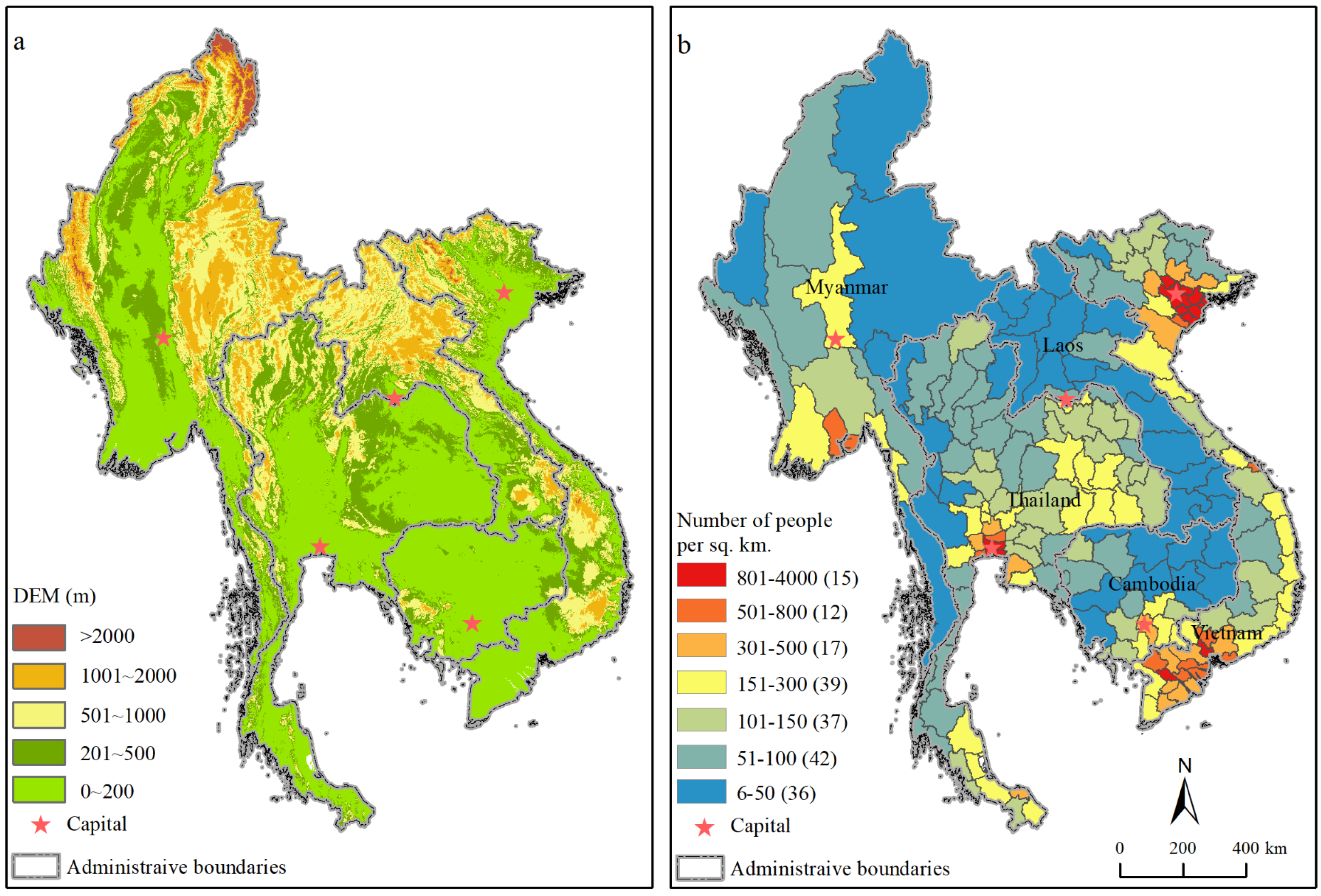
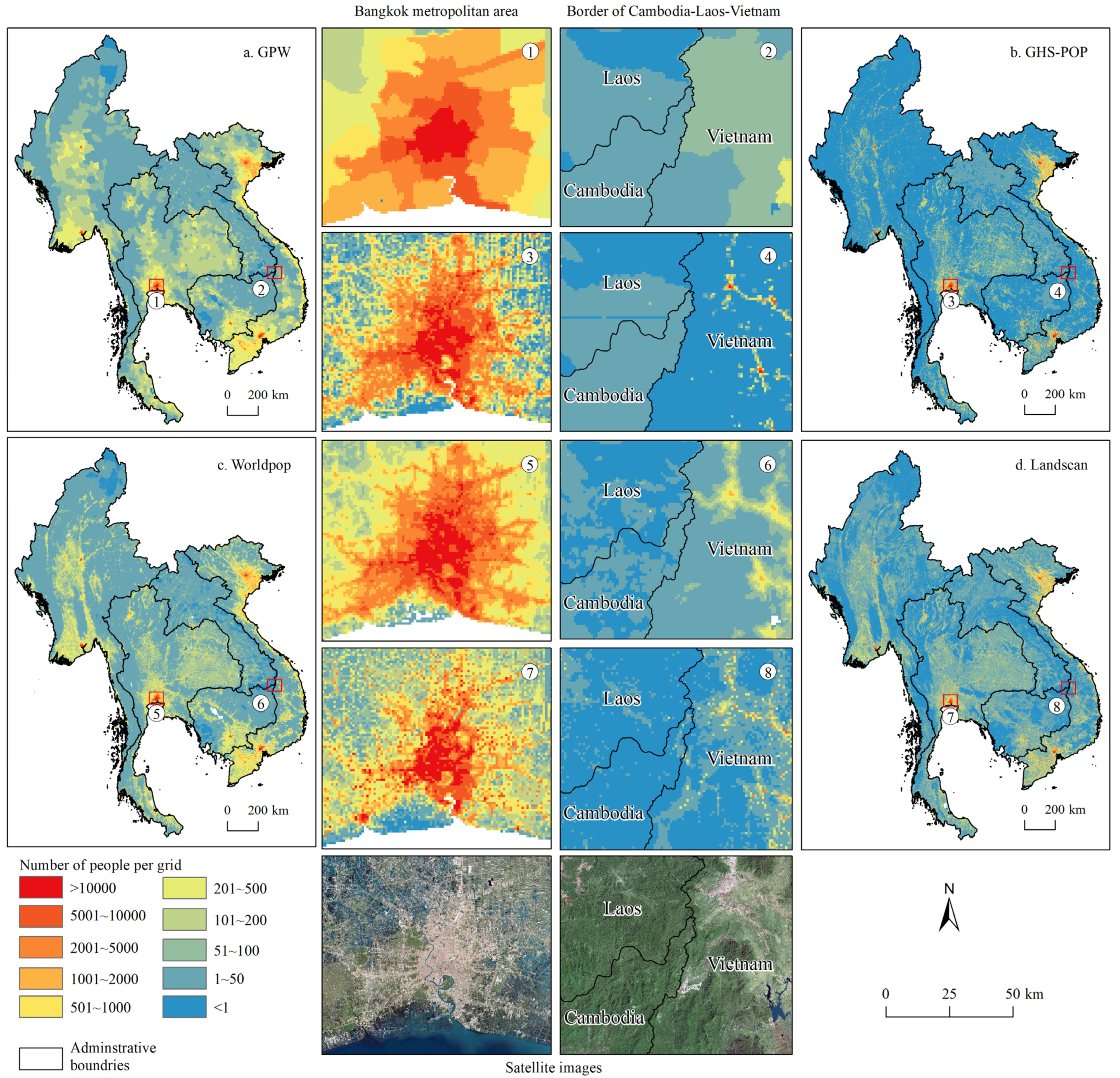
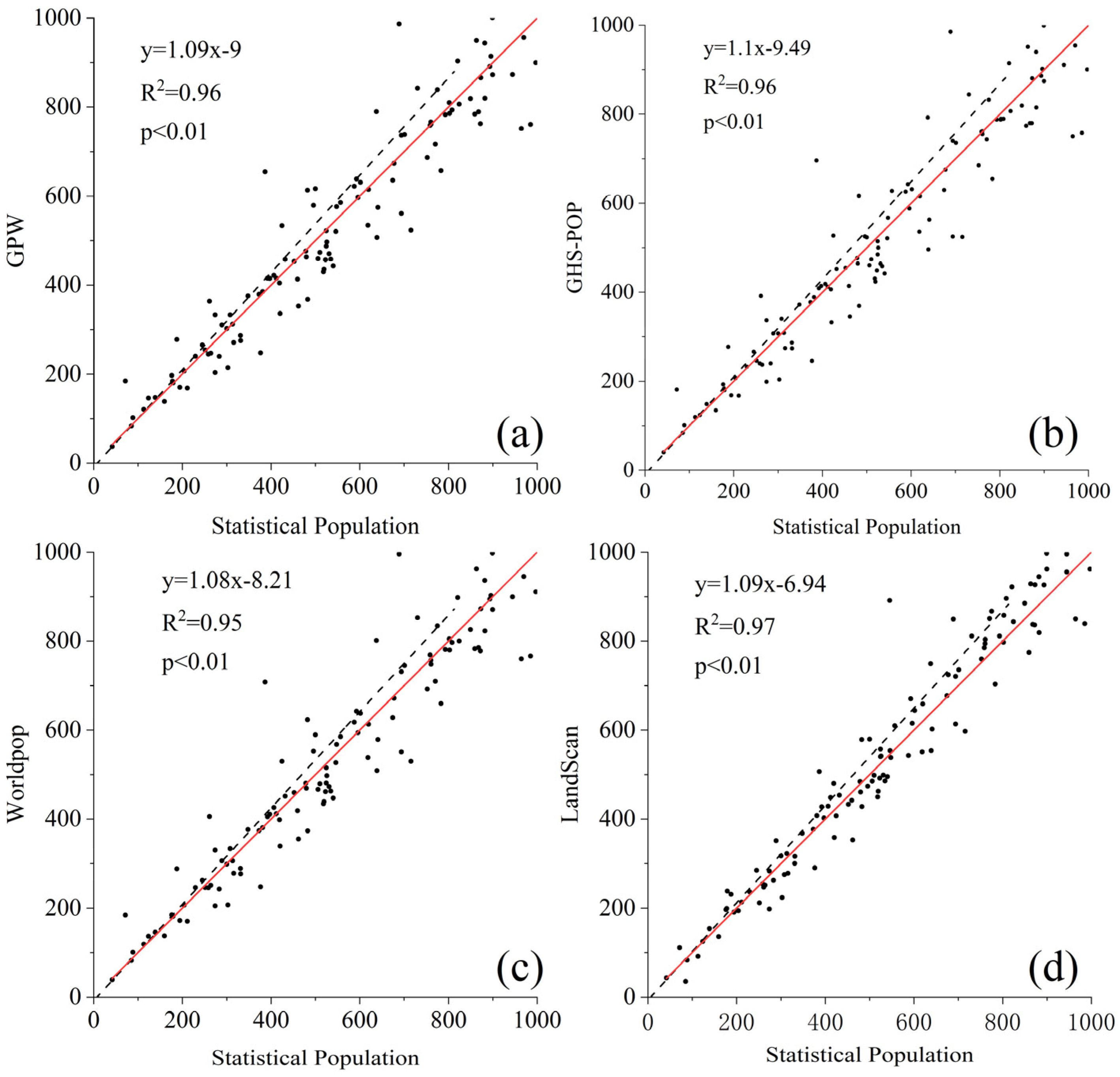
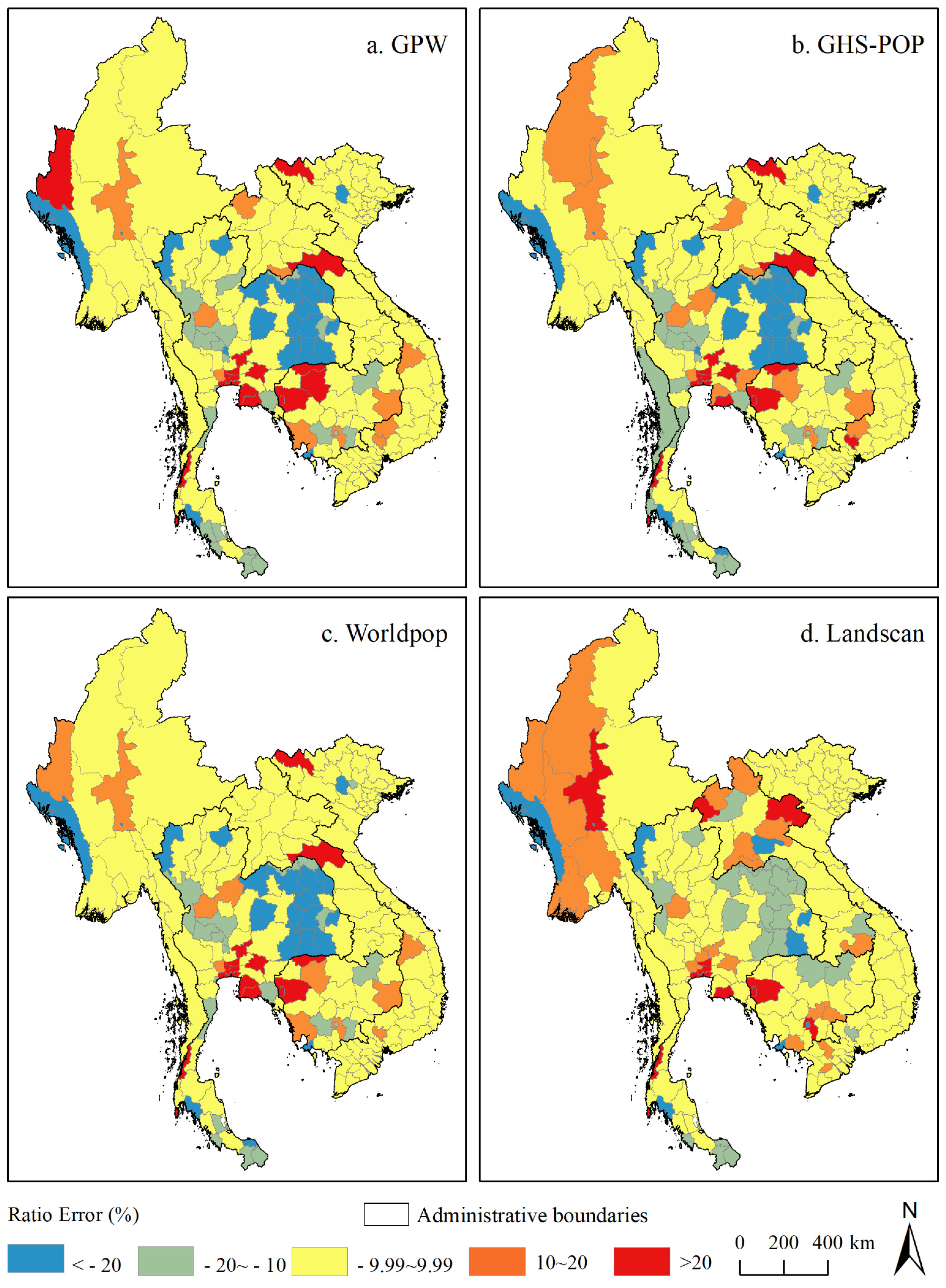
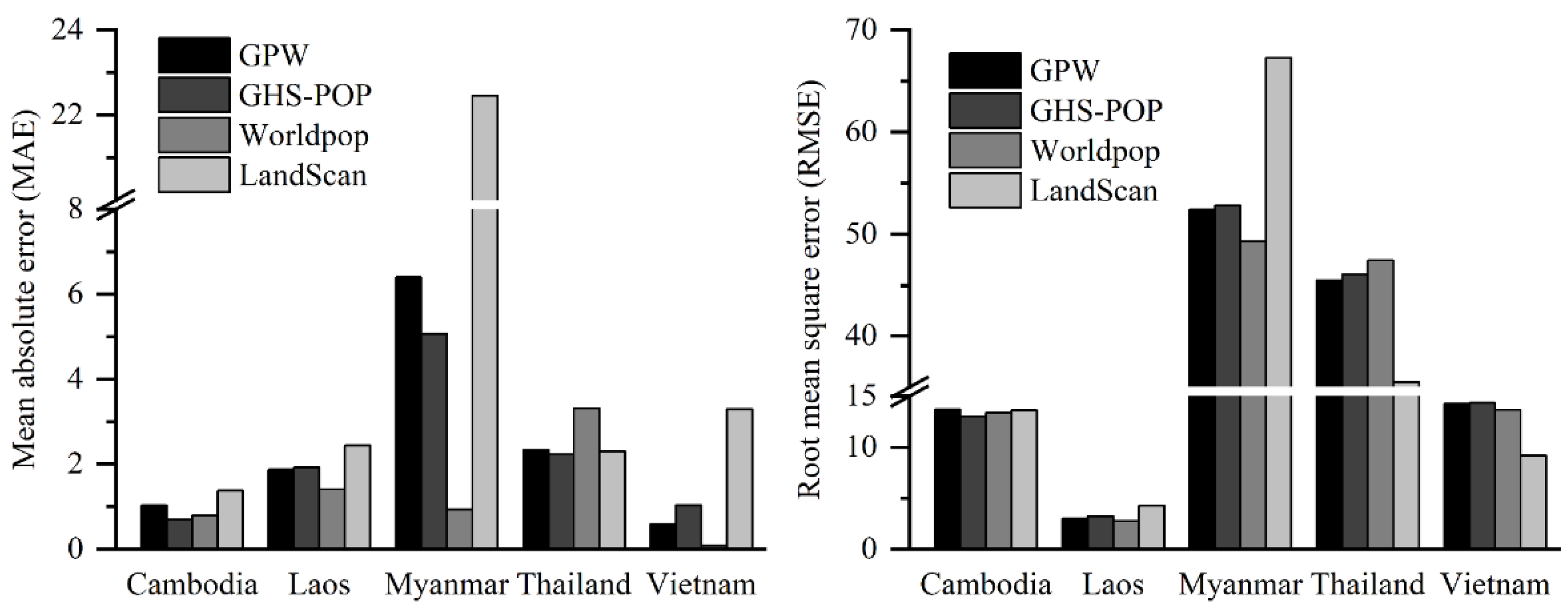
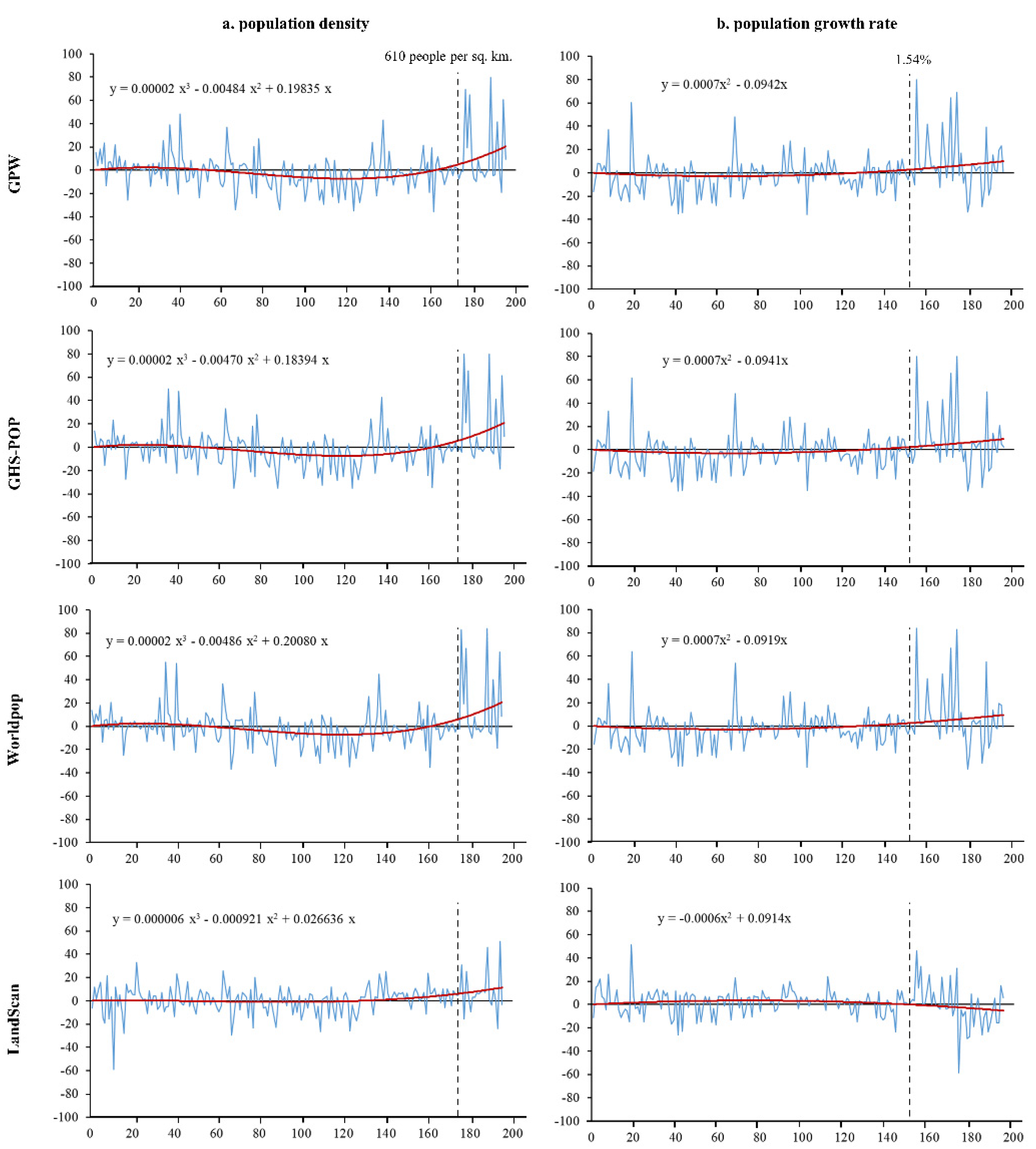
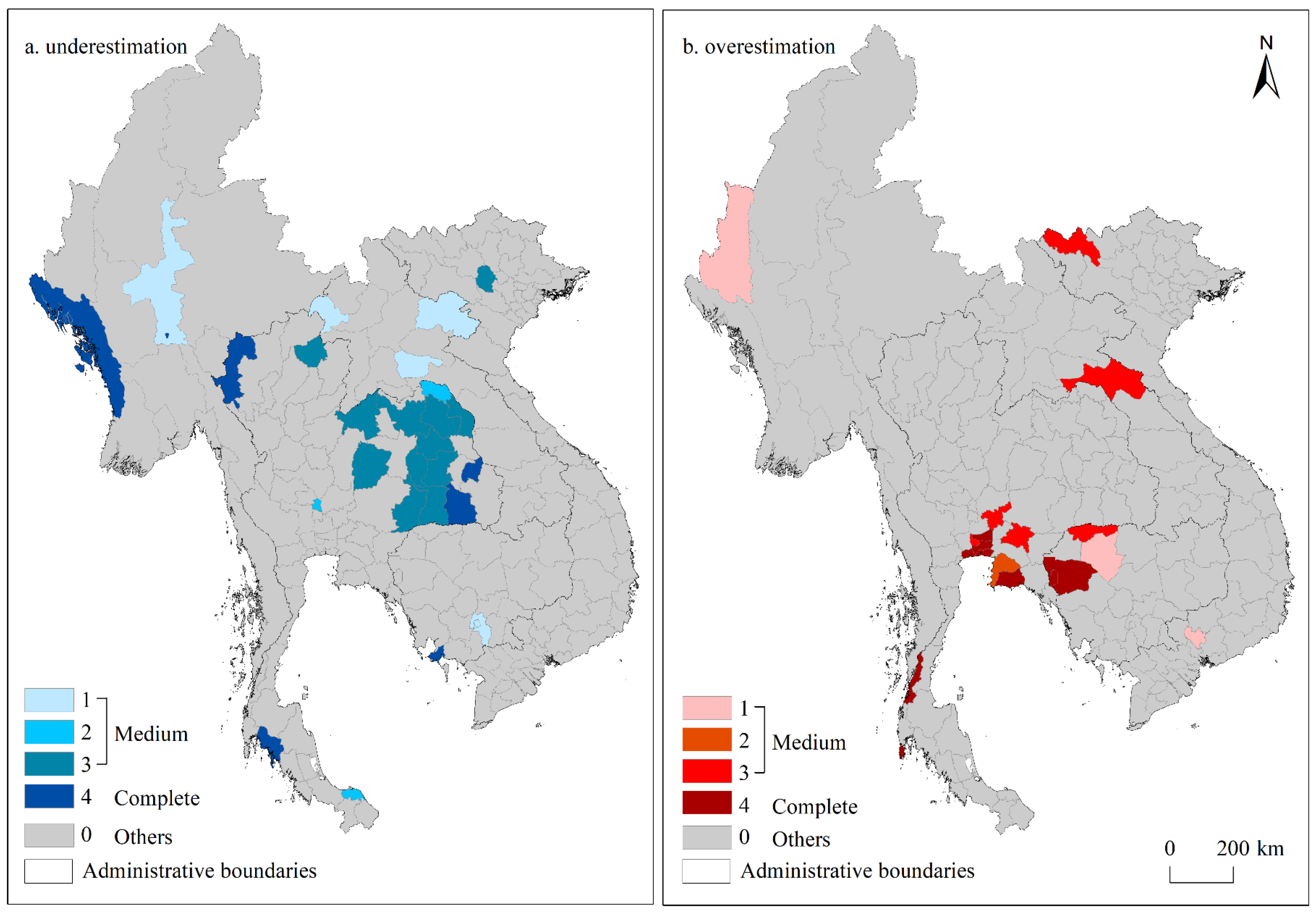
| Version | Producers | Spatial Resolution | Years | Simulation Methods | Population Sources and Auxiliary Data | Publications Indexed by the WoS (as of 27 September 2021) | |
|---|---|---|---|---|---|---|---|
| Unmodeled | GPW v4.11 UNWPP-adjusted population count | Columbia University and Center for International Earth Science Information Network (CIESIN) | 1 km | 2000, 2005, 2010, 2015, and 2020 | Areal weighting | Census, administrative boundaries, and World Population Prospects (2015 Revision) | 31 |
| Lightly modeled | GHS-POP R2019A | European Commission | 250 m and 1 km | 1975, 1990, 2000, and 2015 | Dasymetric refinement | GPW v4 and remote sensing imagery | 72 |
| Highly modeled | WorldPop population count | University of Southampton and other organizations | 100 m and 1 km | 2000–2020 (time series) | Multivariate dasymetric | Census, geographic data, night-time lights, and volunteer geographic information | 70 |
| LandScan | Oak Ridge National Laboratory | 1 km | 1998 and 2000–2019 (time series) | Smart interpolation | Census, geographic data, and remote sensing imagery | 133 |
| Datasets | MAE | RMSE | CC |
|---|---|---|---|
| GPW | 13.74 | 33.18 | 0.973 |
| GHS-POP | 13.78 | 33.52 | 0.973 |
| WorldPop | 13.29 | 33.80 | 0.971 |
| LandScan | 11.88 | 29.74 | 0.978 |
| Error Rate/% | GPW | GHS-POP | WorldPop | LandScan | ||||
|---|---|---|---|---|---|---|---|---|
| Number of Provinces | Proportion of Total Population/% | Number of Provinces | Proportion of Total Population/% | Number of Provinces | Proportion of Total Population/% | Number of Provincse | Proportion of Total Population/% | |
| <−20 | 21 | 9.19 | 22 | 9.48 | 20 | 9.22 | 9 | 4.13 |
| −20~−10 | 22 | 5.68 | 22 | 6.27 | 21 | 5.61 | 23 | 8.01 |
| −10~10 | 125 | 71.82 | 125 | 68.41 | 130 | 72.32 | 131 | 65.70 |
| 10~20 | 12 | 5.90 | 13 | 8.87 | 11 | 6.09 | 22 | 14.01 |
| >20 | 18 | 7.41 | 16 | 6.97 | 16 | 6.76 | 13 | 8.15 |
| Classification | Datasets | MAE | RMSE | CC | |
|---|---|---|---|---|---|
| Population Density (People per sq. km.) | Type A (≤610) | GPW | 10.25 | 19.44 | 0.980 |
| GHS-POP | 10.20 | 19.37 | 0.980 | ||
| WorldPop | 9.65 | 18.60 | 0.980 | ||
| LandScan | 9.49 | 21.16 | 0.982 | ||
| Type B (>610) | GPW | 37.84 | 78.15 | 0.927 | |
| GHS-POP | 38.49 | 79.38 | 0.928 | ||
| WorldPop | 38.46 | 81.56 | 0.924 | ||
| LandScan | 28.44 | 62.51 | 0.932 | ||
| Population growth rate/% | Type C (≤1.54) | GPW | 10.43 | 30.56 | 0.958 |
| GHS-POP | 10.45 | 30.92 | 0.958 | ||
| WorldPop | 10.14 | 31.66 | 0.955 | ||
| LandScan | 9.22 | 26.33 | 0.975 | ||
| Type D (>1.54) | GPW | 25.30 | 41.06 | 0.965 | |
| GHS-POP | 25.41 | 41.36 | 0.965 | ||
| WorldPop | 24.32 | 40.39 | 0.964 | ||
| LandScan | 21.19 | 39.42 | 0.964 | ||
Publisher’s Note: MDPI stays neutral with regard to jurisdictional claims in published maps and institutional affiliations. |
© 2021 by the authors. Licensee MDPI, Basel, Switzerland. This article is an open access article distributed under the terms and conditions of the Creative Commons Attribution (CC BY) license (https://creativecommons.org/licenses/by/4.0/).
Share and Cite
Yin, X.; Li, P.; Feng, Z.; Yang, Y.; You, Z.; Xiao, C. Which Gridded Population Data Product Is Better? Evidences from Mainland Southeast Asia (MSEA). ISPRS Int. J. Geo-Inf. 2021, 10, 681. https://doi.org/10.3390/ijgi10100681
Yin X, Li P, Feng Z, Yang Y, You Z, Xiao C. Which Gridded Population Data Product Is Better? Evidences from Mainland Southeast Asia (MSEA). ISPRS International Journal of Geo-Information. 2021; 10(10):681. https://doi.org/10.3390/ijgi10100681
Chicago/Turabian StyleYin, Xu, Peng Li, Zhiming Feng, Yanzhao Yang, Zhen You, and Chiwei Xiao. 2021. "Which Gridded Population Data Product Is Better? Evidences from Mainland Southeast Asia (MSEA)" ISPRS International Journal of Geo-Information 10, no. 10: 681. https://doi.org/10.3390/ijgi10100681
APA StyleYin, X., Li, P., Feng, Z., Yang, Y., You, Z., & Xiao, C. (2021). Which Gridded Population Data Product Is Better? Evidences from Mainland Southeast Asia (MSEA). ISPRS International Journal of Geo-Information, 10(10), 681. https://doi.org/10.3390/ijgi10100681







